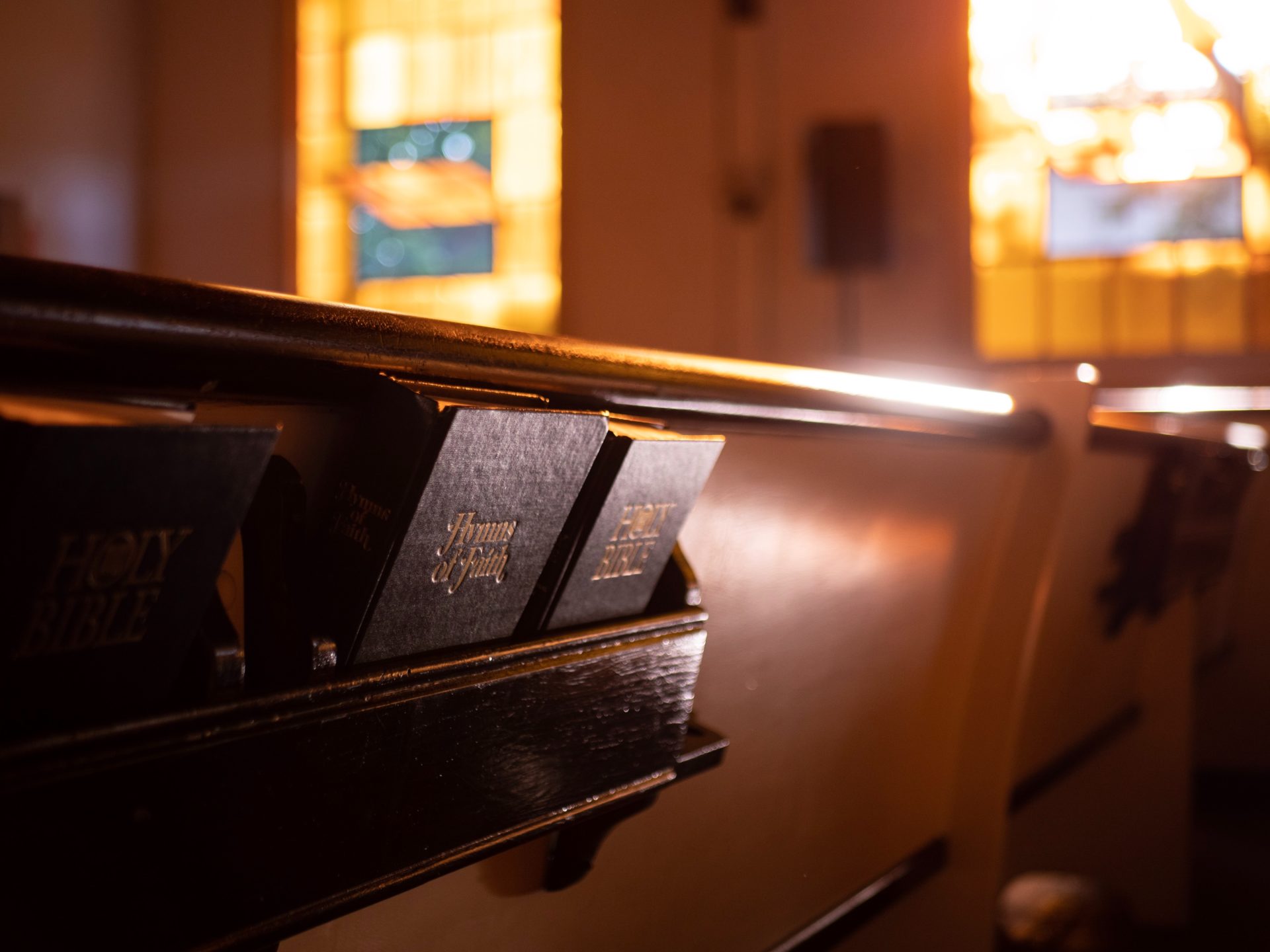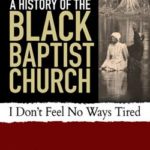
Church pew with hymnal and Bible.
Photo by Aaron Burden on Unsplash
The origin and evolution of the Black Baptist church
(Book excerpt)
Black Baptists evolved from a need to address the inequities caused by racism and discrimination. They began to form their own congregations because they refused to accept second-class status within white Baptist churches. Accordingly, as historian James Melvin Washington notes, “the history of Black Baptists is intimately interwoven with the general history of Baptists in the United States.”[i]
Black Baptist churches in the United States are believed to have begun around 1750. Debate over which Black Baptist church was first on American soil continues until this day. At least three Baptist churches claim to be the first Black congregation.[ii]
Usually considered first is Silver Bluff Church in Aiken County, South Carolina, fourteen miles northwest of Savannah, Georgia. Silver Bluff formed between 1773 and 1775 on George Galphin’s plantation near today’s Augusta, Georgia. After hearing Baptist minister Matthew Moore, the enslaved George Liele converted and became a regular preacher at Silver Bluff.[iii]
George Liele was baptized by Moore. With the support of his master, Henry Sharpe, he was soon licensed and ordained to preach. Liele was freed when the Revolutionary War began and shared his faith with enslaved Africans up and down the Savannah River. Through his evangelistic work, his friend David George converted to Christianity. George was a runaway slave who had been re-enslaved by Native Americans and later ended up as Galphin’s property. After his conversion, David George became Silver Bluff’s first pastor. According to biographer Grant Gordon, his ministry work earned him the distinction of being the first Black Baptist pastor of an all-Black Baptist North American congregation.
David George’s pastorate was short-lived because of the Revolutionary War. The British seized Galphin’s trading post, and he fled, leaving all his slaves behind. At this point, David George, along with most of his congregation, pledged their loyalty to Britain and moved south to Yamacraw, near Savannah.[iv] The transplanted congregation became the nucleus for the birth of the independent Black Baptist church movement in that southern city. David George and members of the disbanded Silver Bluff Church headed to Savannah, where George Liele had organized a church named the First African Baptist Church, also known as First Colored Baptist Church, in 1777.[v]
As the war progressed, George thought the British would be victorious, so he fled in 1782 to Nova Scotia, Canada, where he continued his missionary work. He planted the Shelbourne Baptist Church in Nova Scotia and became the first pastor of a Black Baptist church in Nova Scotia. In 1792, he and his friend John Marrant migrated to Sierra Leone in West Africa, where George baptized five new believers in the Sierra Leone River. By traveling to Africa, David George became the first Baptist pastor founder of the first Black Baptist church on the west coast of Africa.[vi]
Liele’s departure left Savannah’s First African Baptist Church without a pastor until 1788. The Savannah church survived the war years but struggled. Claiming direct descendance from the Silver Bluff Church, the First African Baptist Church’s website reads:
First African Baptist Church (FABC) was organized in 1773 under the leadership of Reverend George Liele. The 1773 organization date for the church makes it clear that FABC is older than the United States (1776).[vii]
Jesse Peters/Galphin chose not to flee Savannah for Nova Scotia with George or to Jamaica with Liele. Peters and others who had left Silver Bluff remained in Savannah, where Peters actively preached. Associated with the Silver Bluff Church and carrying ordination papers, Peters and the remaining members returned to Silver Bluff in 1788 and resurrected the church. The sixty-member church vanished from recorded history in 1793, but a new congregation surfaced in Augusta, Georgia, with Peters as pastor. He remained there until 1791. Some records show the church’s name as the First Baptist Church of Augusta, later changed to Springfield Baptist Church. The Springfield Baptist Church of Augusta maintains heirship as an offspring of the Silver Bluff Church and thus, like First African Baptist, considers itself to be “the oldest Negro Baptist Church in America.”[viii]
The First African (Colored) Baptist Church in Savannah remained active after George Liele’s departure. As noted earlier, four converts to Christianity—Rev. Andrew Bryan; his wife, Hannah Bryan; Kate Hogg; and Hagar Simpson—formed the nucleus of First African Baptist Church’s early membership. Andrew Bryan was baptized by Liele and was authorized to preach by his master. Bryan was ordained on January 20, 1788, and led the First African (Colored) Baptist Church in Liele’s absence.
That same year, Bryan purchased his freedom and established the Black Baptist Savannah congregation, chartered under the name Bryan Street African Baptist Church. By 1800, the congregation grew to about seven hundred members and reorganized as the First African Baptist Church.
When Bryan died in 1812, his nephew, Andrew Cox Marshall, assumed the pastorate. Marshall acquired his freedom with funds lent to him by merchant and banker Richard Richardson. Marshall was one of Savannah’s most distinguished African American leaders in the antebellum period. As a formerly enslaved African, Marshall traveled around the country to preach and organized the first Black Sunday school in North America. He served as President George Washington’s personal servant during his Savannah visit in 1791 and later addressed the Georgia state legislature.
In 1832, the First African Baptist Church was schismatized when Marshall allowed white minister Andrew Campbell of Virginia to preach at the church. Campbell’s reform doctrine was met with suspicion by church members. The matter came before the Association of Georgia Baptist churches, known as the Sunbury Association. Following proceedings in November of that year, the church was condemned for its role in the doctrinal debacle, and its membership with the association dissolved.
Later, the First African Baptist Church was readmitted to the association after Marshall disavowed his support of Campbell and sought forgiveness. Marshall’s association with Campbell resulted in a church split. A majority of the congregation sided with Marshall, who moved with him to a new location on Franklin Square. About 105 members remained at the original site under Deacon Adam Johnson’s leadership, and they established the Third African Baptist. A Second African Baptist Church already existed. The church later became known as First Bryan Baptist Church. The dispute over which church could claim to be the oldest African American Baptist church in the state was brought before the State Missionary Baptist Connection of Georgia in 1888. After intense deliberations, the organization’s adjudicating committee favored the First African Baptist Church over First Bryan Baptist Church.[ix]
Today, First African Baptist Church in Savannah is often recognized as the first continuously existing Black Baptist church in America. Despite this, the First (Colored) Baptist Church of Petersburg in Petersburg, Virginia, established by free Africans in 1774, like Silver Bluff Baptist Church and First African Baptist Church, contends for this distinction.
Historian Mechal Sobel maintains that the First (Colored) Baptist Church of Petersburg was first the Bluestone Church in Lunenburg (now Mecklenburg) County, Virginia, in 1758. Two white missionaries started a predominantly slave congregation on William Byrd III’s plantation on the Bluestone River around 1758.[x] Unfortunately, Byrd, squandered his family’s fortune. He parceled out much of his inheritance, including his slaves, to pay his debts. The effect for enslaved Christians on the Byrd plantation was that Black congregants were scattered across various parts of the state.
The church that first met in Lunenburg County was later reconstituted in Prince George’s County in 1820. The congregation, originally named the First Colored Church of Petersburg, later became known as the First Baptist Church of Petersburg.
Henry H. Mitchell argues that no record exists of an active church between the years 1774 and 1830 for Africans in Prince George’s County. The earliest “colored” church Mitchell found was Elam Baptist Church, in Charles City County, north of Prince George’s County, twelve miles from Petersburg. Elam Baptist was founded in 1810 with the aid of a colored church in Petersburg, which some believe was the racially mixed Gillfield Church (also known as Second African Baptist) founded in 1788. By 1820, Elam was an all-Black congregation. Elam’s records suggest that ten of the founding members rowed by boat to worship, possibly at First (Colored) Baptist Church of Petersburg.[xi]
In summary, the Black congregations that regard themselves as the first Black Baptist Church are: Silver Bluff, First African Baptist of Savannah, First Baptist of Petersburg, Third African Baptist in Savannah, now known as First Bryan, and Springfield Baptist Church. Historians Walter H. Brooks and Albert J. Raboteau recognize the Silver Bluff Baptist Church of Savannah, Georgia, as the first independent Black Baptist church in America.
The Black Baptist church movement that began among enslaved Africans in the South during the Revolutionary War gave birth to the Black independent or separate church movement in the North.
 Excerpted from A History of the Black Baptist Church: I Don’t Feel No Ways Tired by Wayne E. Croft Sr. copyright © 2020 by Judson Press. Used by permission of Judson Press.
Excerpted from A History of the Black Baptist Church: I Don’t Feel No Ways Tired by Wayne E. Croft Sr. copyright © 2020 by Judson Press. Used by permission of Judson Press.The views expressed are those of the author and not necessarily those of American Baptist Home Mission Societies.
[ii] Mechal Sobel, Trabelin’ On: The Slave Journey to an Afro-Baptist Faith (Westport, Connecticut: Greenwood Press, 1988), 104–105.
[iii] Walter H. Brooks, “The Evolution of the Negro Baptist Church,” The Journal of Negro History vol. 7 no. 1 (April 1922): 11–22; Brooks, “The Priority of the Silver Bluff Church and Its Promoters,” The Journal of Negro History. 7.2 (1922): 172–196; John Parmer Gates, “George Liele: A Pioneer Negro Preacher,” The Chronicle vol. 5 no. 3 (1943): 118–29; Edward A. Holmes, “George Liele: Negro Slavery’s Prophet of Deliverance,” Baptist Quarterly vol. 20 (1964): 340–351; Beverly Brown, “George Liele: Black Baptist and Pan-Africanist, 1750–1826,” Savacou 9–11 (1975): 58–67.
[iv] Grant Gordon, From Slavery to Freedom: The Life of David George, Pioneer Black Baptist Minister (Hantsport, Nova Scotia: Lancelot Press, 1992).
[v] Mitchell, Black Church Beginnings, 58. Mitchell has the date listed as 1775. See also, James Meriles Simms, The First Colored Baptist Church in North America (New York: Negro Universities Press, 1969).
[vi] Alan Neely in Biographical Dictionary of Christian Missions, ed. Gerald H. Anderson (New York: Macmillan Reference USA, 1998), 400–1.
[vii] https://firstafricanbc.com/history.php (accessed July 3, 2019).
[viii] Brooks, Silver Bluff Church, 33–34. See also Leroy Fitts, A History of Black Baptists (Nashville: Broadman Press, 1985), 33–9; L. H. Whelchel, The History and Heritage of African American Churches: A Way Out of No Way (St. Paul, MN: Paragon House, 2011), 106; Mitchell, Black Church Beginnings, 59.
[ix] https://www.visitaugusta.com/listing/springfield-baptist-church/46/, accessed July 3, 2019; https://georgiainfo.galileo.usg.edu/topics/historical_markers/county/richmond
[x] http://archives.nypl.org/uploads/collection/generated_finding_aids/scm20852.pdf, accessed July 9, 2019. Sobel, 102. Mitchell, Black Church Beginnings, 54–56. Brooks, Walter H., The Silver Bluff Church: A History of Negro Baptist Churches in America (Washington: R.L. Pendleton, 1910), 5. Raboteau, Slave Religion, 139–40.
[xi] The original story can be found at: http://www.baptistpress.com/10621/firstperson- in-search-of-americas-firstBlack-baptist-congregation.


